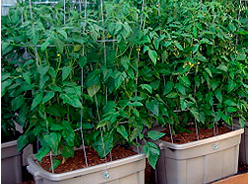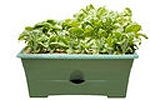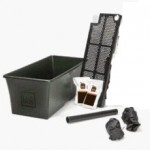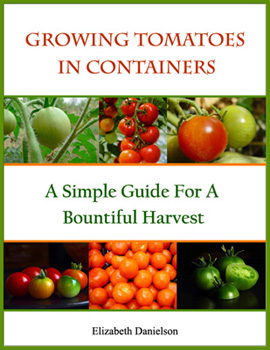 Container gardening vegetables is very easy and one of the best ways to garden, especially if you don’t have good growing soil or if you don’t have the room for a traditional garden. If you have a deck or a patio, you can grow vegetables in containers. Even if you have a lot of space, once you learn how to plant a vegetable garden in containers, you may never go back again to raking, hoeing and tilling a patch in your yard to grow your vegetables.
Container gardening vegetables is very easy and one of the best ways to garden, especially if you don’t have good growing soil or if you don’t have the room for a traditional garden. If you have a deck or a patio, you can grow vegetables in containers. Even if you have a lot of space, once you learn how to plant a vegetable garden in containers, you may never go back again to raking, hoeing and tilling a patch in your yard to grow your vegetables.
There are many benefits to container gardening vegetables and perhaps one of the biggest benefits is that anyone can do it. Another benefit is that it’s very easy to move your plants should you need to do so. For example, if it’s raining too hard and you don’t want your plants to receive too much water at one time, you can move them to a protected area. You can also move them if you feel they are getting too much or too little sun.
It is much easier to keep your vegetable plants well-fed and watered when they are grown in containers. It is also much easier to control the fertilizer your plants get and ensure they receive the proper amount when they are confined to the smaller area of a container. Even though fertilizer can sometimes be washed away quicker in a smaller area, you will be able to make sure your plants are getting the amounts they need by fertilizing on a regular basis.
Container vegetable gardening allows you to extend the growing season of your plants. You can start early by growing your vegetable plants indoors in smaller containers. If you use seeds you can start them in peat pots that are available just about any place that sells seeds or gardening supplies. Make sure you place the pot in a warm area that gets sufficient sunlight. The seeds should be started between 4 and 8 weeks before you plan to transplant them to a larger container.
Once the weather has stabilized, you can move them to larger containers outdoors being careful to avoid injury to the root system. Vegetable plants are typically transplanted once they develop a few true leaves. Toward the end of the growing season, you can protect your plants by wrapping the containers in blankets or other insulating materials to keep the soil warm.
Container Gardening Vegetables – Choosing The Right Garden Containers
 You can use just about any type of container for container gardening vegetables. Some examples are gallon cans, wooden boxes, bushel baskets, and even plastic storage bins. The size of your containers will depend on what type of plants you intend to grow. Tomato plants and pepper plants require 5 gallon containers and smaller plants, such as leaf lettuce, green onions and herbs only need 1 gallon containers.
You can use just about any type of container for container gardening vegetables. Some examples are gallon cans, wooden boxes, bushel baskets, and even plastic storage bins. The size of your containers will depend on what type of plants you intend to grow. Tomato plants and pepper plants require 5 gallon containers and smaller plants, such as leaf lettuce, green onions and herbs only need 1 gallon containers.
Regardless of what size container you use, it must drain properly in order for your plants to grow successfully. Containers with drain holes located on the sides are better and the holes should be located about ¼ to ½ inch from the bottom of the container.
The following chart will give you some guidelines as to what type of container gardening vegetable plants do well and the size of the container that is required.
| Vegetable | Container Size | Plants Per Pot | Notes |
| Beets | 2 Gallons | Thinned to 2-3 inches apart | |
| Broccoli | 2 Gallons | 1 | |
| Cabbage | 1 Gallon | 1 | |
| Carrots | 1 Gallon | 2 – 3 | Make sure pot depth is a least 2 inches deeper than length of carrots |
| Cucumber | 1 Gallon | 1 | |
| Eggplant | 2 Gallons | 1 | |
| Green Beans | 2 Gallons | 2 – 3 | Plants must be spaced at least 3 inches apart. Only use the number of plants that will allow this spacing. |
| Green Onions | 1 Gallon | 3 – 5 | |
| Leaf Lettuce | 1 Gallon | 4 – 6 | |
| Parsley | 1/2 Gallon | 1 | |
| Peppers | 5 Gallons | 2 | |
| Radishes | 2 Gallons | 3 | Thinned to 1-2 inches apart |
| Spinach | 1 Gallon | 2 | Thinned to 3 inches apart |
| Squash | 5 Gallons | 1 | |
| Tomatoes | 5 Gallons | 1 | |
| Turnips | 2 Gallons | 2 |
|
Click HereFor More Information About The Green Earth Box Ready-to-Grow System |
Container Gardening Soil
As with traditional gardens, the growing media for container gardening must provide water, nutrients, and support and, it must also drain well. When it comes to vegetable container gardening, choose a lightweight potting mix and do not use soil straight from a garden. You can find good packaged potting mix at garden centers or retail stores that carry gardening supplies. When filling your containers with soil, leave two inches between the top of the soil and the top of the container so you can add mulch later.
If you find that the packaged potting mixes are too expensive, you can mix your own. In a 1 gallon bucket use one part garden loam, one part peat moss, and one part builder’s sand. The sand should be course and clean. Also add a slow-release fertilizer to the mix. Use a complete balanced type such as 10-10-10 or 13-13-13. The ratio of slow release fertilizer to be used in your mix ½ tablespoon of fertilizer to one gallon of the soil mix.
About mid-season you should start using a water soluble fertilizer because potting mixes typically don’t retain the nutrients very well. Miracle Gro® 15-30-15 is a good water soluble fertilizer that works well for container gardening. Preparing a solution to add to the soil is the easiest way to fertilize growing plants. Follow the dilution and usage directions on the label of of the fertilizer to ensure your plants receive the correct amounts.
You should leach unused fertilizer out of the soil at least once a week. You can do this by watering with enough plain tap water so it starts to drain out of the bottom of the container. When you leach the soil at least once a week, it will flush out any harmful minerals.
Watering Your Container Garden
 Proper watering is a key element in determining the success of your container garden. Watering once a day is typically adequate, however, if your containers don’t have proper drainage, it is possible to over-water the plants and kill them. When the soil become too water-logged, it deprives the plants of oxygen and they can die. In addition, it is important that you water the roots and not the leaves of the plant. It is possible to cause disease growth on the plants by wetting the foliage.
Proper watering is a key element in determining the success of your container garden. Watering once a day is typically adequate, however, if your containers don’t have proper drainage, it is possible to over-water the plants and kill them. When the soil become too water-logged, it deprives the plants of oxygen and they can die. In addition, it is important that you water the roots and not the leaves of the plant. It is possible to cause disease growth on the plants by wetting the foliage.
A good way to prevent water loss in your containers is to use mulch on top of the soil. If you use mulch, don’t place it right against the plant stem. Leave a small circle of soil by the stem uncovered.
Sunlight For Your Container Garden
Almost all plants need some degree of sunlight to grow. Vegetable plants typically grow better in full sunlight than in shade, and some need complete sunlight. Plants such as lettuce, cabbage, and spinach are able to tolerate more shade than onions, beets, and radishes, which are root plants. Plants that bear fruit, such as tomatoes, peppers and cucumbers need complete sunlight. This is why container gardening can be so successful, because you can move your containers around so your plants are given the best growing conditions.
Plant Diseases And Insects
Container gardening does not mean your vegetable plants will be free of diseases and insects. They are susceptible to the same pests and diseases as those of that plants grown in a traditional garden. This is why it is important that you periodically check your plants for disease and insects that feed on fruit. If you are unsure of what to look for, Vegetable MD Online has a website with Disease Fact Sheets Listed by Crop.
To eliminate fruit-feeding pests, you can use EPA-approved fungicides and insecticides. For those who wish to keep their container gardens as organic as possible, you may prefer to use organic insecticides and pesticides.
Planting Zones
Planting zones, also known as “USDA Plant Hardiness Zones,” consist of 11 regions encompassing the United States, Mexico and southern Canada and they are defined by a 10 degree Fahrenheit difference in the average annual minimum temperature. The lower the numbers, such as zones 1 and 2a are the coldest and they are found in Canada. The higher numbers, the hotter the zones with zone 11 being the hottest, found in Mexico and Hawaii.
You can find more information about planting zones by visiting the USDA Plant Hardiness Zone Map.
Container Gardening Ideas
 Before you even purchase anything for your container garden, it’s important to know what types of vegetable plants you want to grow. The types of plants you choose should be suitable for growing in containers and, they should be vegetables that you and your family like to eat. You should also take into consideration that plants that grow larger, such as standard-size tomatoes, will need a stake or a cage to keep the vines up.
Before you even purchase anything for your container garden, it’s important to know what types of vegetable plants you want to grow. The types of plants you choose should be suitable for growing in containers and, they should be vegetables that you and your family like to eat. You should also take into consideration that plants that grow larger, such as standard-size tomatoes, will need a stake or a cage to keep the vines up.
Here are some ideas to get you started:
- Tomatoes are easy to grow in containers. Garden centers and some retail stores sell tomato plants that have already been started in small containers and for beginners, these may be easier than starting tomato plants from seeds.
- As with tomato plants, cucumber plants can be grown upright using a tomato cage. The cucumber plant has tendrils that will latch on to the the cage and the plant will grow upright.
- Some vegetable plants, like lettuce, spinach, radish and beets, can be grown in smaller containers. Green onions, radishes and beets can even be grown in a cake pan!
Based on the space you have available, use the chart above that lists the size of the containers required to grow specific vegetables to help you plan your container vegetable garden. If you have a backyard or a large deck or patio, you will be able to choose more of a variety of plants than if your space is limited. But even with a limited amount of space, you can still have a very successful container garden.
There are many benefits to container gardening vegetables and perhaps the best of all is being able to step right outside of your kitchen and pick you own fresh produce!
Recommended Reading
Related Articles:

 The Green Earth Box Ready-to-Grow System is the new secret way to grow larger, higher-quality flowers, herbs, vegetables and plants. Great for container gardening or seed starting! Grow vegetables, fruits, herbs and flowers with EarthBox. Our Green Earth Box System includes 1 EarthBox unit, 1 Aeration Screen, 1 Water Fill Tube, 2 Fitted Covers, 4 Casters, 20 oz. Bag of 7-7-7 Fertilizer, and 16 oz. Bag of Dolomite w/ Trace Elements. All durable plastic components are UV stabilized. Holds 2.0 C.F. of Potting Mix, Holds 3 Gallons of Water, Product Dimensions 29L x 14W x 11H, Integrated Caster Sockets, One-Year Warranty, Instruction Sheet.
The Green Earth Box Ready-to-Grow System is the new secret way to grow larger, higher-quality flowers, herbs, vegetables and plants. Great for container gardening or seed starting! Grow vegetables, fruits, herbs and flowers with EarthBox. Our Green Earth Box System includes 1 EarthBox unit, 1 Aeration Screen, 1 Water Fill Tube, 2 Fitted Covers, 4 Casters, 20 oz. Bag of 7-7-7 Fertilizer, and 16 oz. Bag of Dolomite w/ Trace Elements. All durable plastic components are UV stabilized. Holds 2.0 C.F. of Potting Mix, Holds 3 Gallons of Water, Product Dimensions 29L x 14W x 11H, Integrated Caster Sockets, One-Year Warranty, Instruction Sheet.
